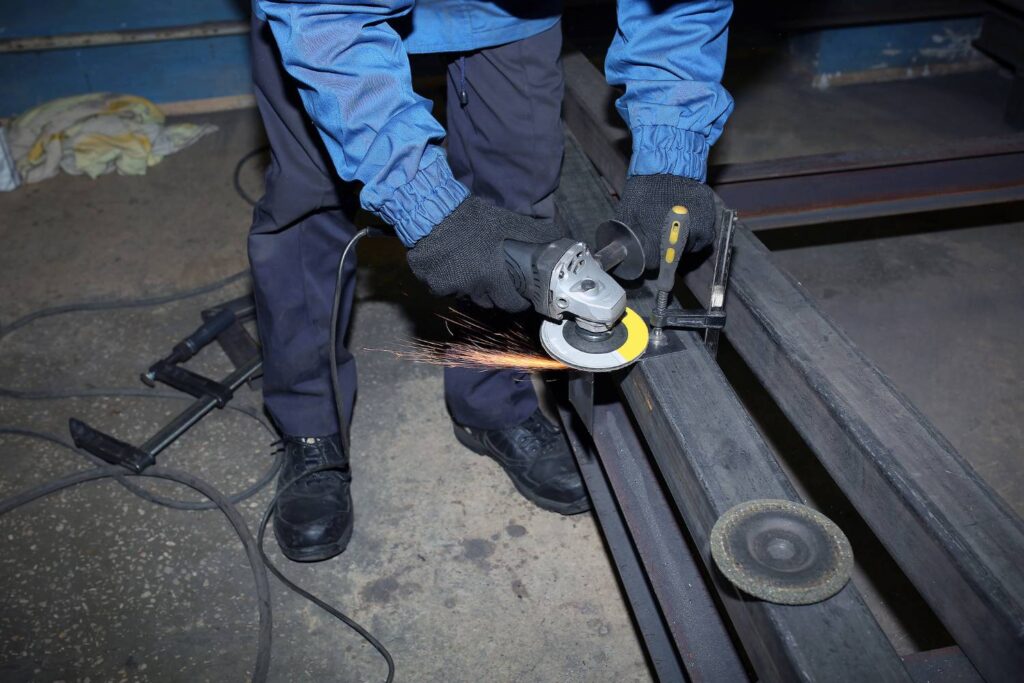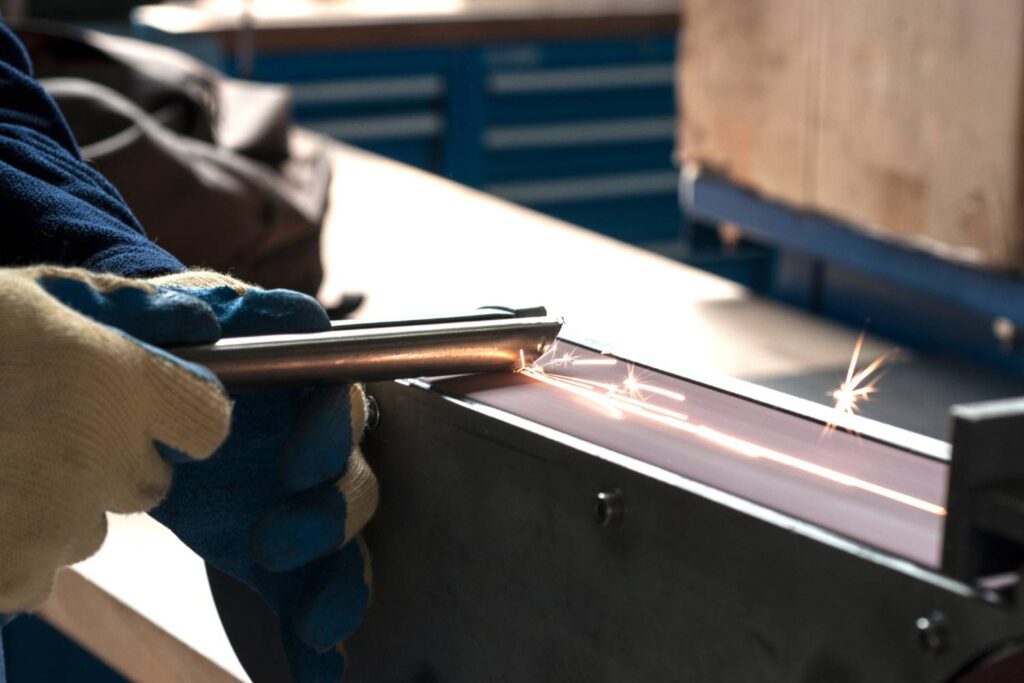Whether it's the gleaming body of an automobile, the robust structure of a bridge, or the precise components of electronic devices, surface finishes and treatments are the unsung heroes that ensure metals perform at their best under various conditions.
This blog delves into the dual objectives of these processes: enhancing the metal's appearance and protecting it against environmental challenges.
From the aesthetic brilliance that catches the eye to the technical prowess that resists corrosion, withstands wear, and ensures longevity, surface finishes and treatments are essential in bridging the gap between a metal's raw potential and its full realization in practical applications.
Join us as we unravel the science and art behind these processes, shedding light on how they are integral to the innovation and sustainability of metal products in our daily lives and the industries that drive our world forward.
Table of Contents
Enhancing Appearance
Metal finishing is a critical process in the manufacturing and crafting of metal products, serving not only to enhance the aesthetic appeal of these items and improve their durability, resistance to corrosion, and surface friction. This guide explores the various techniques and applications of metal finishing, emphasizing its essential role in modern manufacturing.

Fundamental Techniques In Metal Finishing
- Electroplating: This process uses electrical current to coat metals with a layer of another metal, such as nickel or chromium, enhancing corrosion resistance and aesthetics.
- Powder Coating: A dry finishing process where powder material is sprayed onto the metal and cured, resulting in a thick, durable coating.
- Anodizing: Primarily used for aluminium, anodizing forms a corrosion-resistant oxide layer and allows for dyeing in various colours.
- Sandblasting: This method propels abrasive material against the metal to clean and prepare its surface for further finishing.
- Buffing and Polishing: These processes smooth the metal's surface to a mirror-like finish, often for decorative purposes.
- Deburring & Vibro Deburring: Essential for removing rough edges or protrusions on metal, these techniques are crucial for safety, functionality, and aesthetics.
- Shot Blasting: Cleans, strengthens, or polishes metal by propelling small steel or mineral particles against the surface at high speed, preparing metal for further finishing and removing surface contaminants.
- Choosing the Right Metal Finishing Process
- Selecting the appropriate metal finishing process involves considering the material type, the desired outcome (prioritizing durability, aesthetics, or corrosion resistance), environmental conditions, and balancing cost and time efficiency. The choice of process is crucial in achieving the intended quality and functionality of the metal product.
Applications Of Metal Finishing
Metal finishing finds applications across various industries, including automotive (where parts require durability and aesthetics), aerospace (demanding precision and corrosion resistance), consumer electronics (for durable, attractive finishes), and construction (where architectural elements need functionality and aesthetics).
Protection And Durability
Metal finishing encompasses a wide array of processes to enhance metal products' durability, appearance, and environmental protection. This crucial step in manufacturing improves a product's aesthetics through cleaning and polishing and significantly boosts its longevity and resistance to adverse conditions. Let's delve into the various metal finishing processes, highlighting their unique benefits and their pivotal role in product enhancement.
Adding And Altering Metal Finishing Processes
These techniques focus on changing a part's surface by adding a material layer to achieve desired properties like enhanced durability, aesthetics, solderability, and chemical resistance. Common processes include:
- Electroplating involves depositing a metal or alloy onto a substrate, enhancing strength and conductivity. Common materials include brass, copper, gold, nickel, and zinc.
- Electroless Plating: A chemical method that plates metal without electrical power, offering even layering and flexibility in plating thickness.
- Passivation: Used mainly for stainless steel and aluminium, this process forms a protective oxide coating to resist corrosion without altering the material's appearance.
- Hot Blackening: Applies a thin black oxide coating to increase abrasion resistance and provide a matte finish, commonly used in automotive parts and firearms.
- Powder Coating: A dry powder is electrostatically applied and cured to form a durable and attractive finish, superior to traditional liquid paints in resisting chemicals, moisture, and UV light.
- Removing and Reshaping Metal Finishing Processes
- These methods alter a part's surface by removing or reshaping it to achieve a polished, smooth, or specific aesthetic finish. Key techniques include:
- Electropolishing: Uses an electric current to remove metal ions, creating a smooth, shiny surface that improves corrosion resistance and cleaning ease.
- Buff Polishing: Cleans and smooths the surface without electrochemical reactions, preparing metal parts for further finishing, like electropolishing.
- Abrasive Blasting: High-pressure propulsion of abrasive material against the metal surface cleans and prepares it for subsequent treatments, offering a smooth finish and altering shape or surface area as needed.
The Interplay Between Aesthetics And Protection
The intricate relationship between aesthetics and protection in metal finishing is a testament to the multifaceted nature of this process, which transcends mere visual appeal to encompass a broad spectrum of functional benefits. This exploration delves into the nuanced interplay between these two critical aspects, drawing insights from various studies and applications across the field.
Aesthetic Enhancement Through Metal Finishing
Metal finishing, at its core, significantly enhances the visual appeal of metal products. Techniques such as polishing, plating, and anodizing not only impart a lustrous, attractive finish but also accentuate the metal's inherent beauty. This aesthetic enhancement is not merely about superficial beauty; it plays a crucial role in product differentiation and brand identity.
For instance, the reflective sheen of chrome plating has become synonymous with luxury and sophistication in the automotive industry. At the same time, the rugged texture of sandblasted finishes can evoke a sense of durability and robustness.
Protective Benefits Of Aesthetic Finishes
Beyond their visual appeal, aesthetic finishes offer substantial protective benefits. A polished surface, for example, can reduce surface roughness, thereby minimizing the adherence of contaminants and enhancing corrosion resistance.
Similarly, while primarily applied for their visual effect, coatings such as varnishes and waxes create a barrier that protects the underlying metal from environmental factors, including moisture, pollutants, and UV radiation. This dual function underscores the importance of considering aesthetics and protection in selecting finishing techniques.
The Role Of Surface Finishes In Durability And Performance
The protective layer afforded by metal finishing processes plays a pivotal role in extending the lifespan and maintaining the performance of metal products. Hard chrome plating, for instance, provides a visually appealing finish and significantly increases wear resistance, making it ideal for components subjected to high friction and wear.
Similarly, the application of corrosion-resistant coatings can prevent the degradation of metal surfaces exposed to harsh environments, ensuring that the product's aesthetic qualities are preserved over time.
Innovations In Metal Finishing: Balancing Aesthetics And Protection
Recent advancements in metal finishing technologies have focused on developing solutions that optimize both finishes' aesthetic and protective qualities. Nanotechnology, for example, has enabled the creation of coatings that are both visually striking and highly resistant to wear and corrosion.
Developing environmentally friendly finishing processes, such as trivalent chromium plating, also reflects a growing emphasis on sustainability without compromising aesthetic or protective properties.
Technological Advancements And Future Trends
The metal finishing industry is transforming significantly, driven by technological advancements and emerging trends. These innovations are reshaping the landscape of metal finishing, offering new opportunities for efficiency, sustainability, and enhanced performance. Here's a comprehensive overview of the critical advancements and future trends in metal finishing.
Innovations In Metal Finishing Techniques
Recent years have seen the introduction of several promising innovations in metal finishing techniques. These advancements address the growing demand for more resilient, cost-effective, and faster finishing processes. Among these innovations are:
- Hydrophobic and Hydrophilic Prepainted Metal: Developing hydrophobic and hydrophilic coatings for prepainted or coil-coated metals is revolutionizing the industry. These coatings offer enhanced water repellency or retention, leading to easier cleaning and reduced friction. This innovation is particularly beneficial for applications ranging from graffiti-resistant surfaces to medical devices requiring minimal tissue damage.
- Nanotech Coating: Nanotechnology has enabled the creation of coatings that are only a few nanometers thick, offering unprecedented control over metal properties. These nano-scale finishes can improve durability, electrical conductivity, and even antimicrobial properties without significantly altering the mass or appearance of the metal products.
- Green Electroplating: Green electroplating techniques have emerged to address environmental concerns, utilizing less harmful materials and processes. Innovations like aluminium dissolution in water instead of toxic solvents and dry electroplating methods make electroplating more sustainable.
- Graphene Plating: The use of graphene, known for its exceptional strength and flexibility, in metal plating offers new possibilities for enhancing the properties of metal products. Graphene plating can significantly improve corrosion resistance, electrical and heat conductivity, and overall durability.
- Data Analytics: Integrating data analytics into metal finishing processes enables more optimized operations. By analyzing real-time data, companies can make informed decisions to improve efficiency, reduce costs, and enhance product quality.

Emerging Trends And Technologies In Metal Fabrication
The metal fabrication sector is also witnessing the emergence of trends and technologies that complement advancements in metal finishing:
- Automation and Collaborative Robotics (Cobots): Automation, including cobots, is increasingly being adopted in metal fabrication to improve efficiency and address labour shortages. These technologies enhance safety and productivity by taking over dangerous or repetitive tasks.
- 3D Printing and Additive Manufacturing: The adoption of 3D printing in metal fabrication enables the creation of complex parts with high precision and minimal waste. This technology is beneficial for rapid prototyping and producing parts with intricate designs.
- Internet of Things (IoT) and Industry 4.0: Integrating IoT devices in metal fabrication equipment allows for real-time monitoring and optimization of manufacturing processes. This connectivity is paving the way for predictive maintenance and improved operational efficiency.
- Advanced Materials: The use of advanced materials such as high-strength steels, aluminium alloys, titanium alloys, and composites enables the production of lighter, stronger, and more durable metal products. These materials open new possibilities for applications in various industries, including aerospace, automotive, and medical.
Conclusion
Surface finishes and treatments are essential for enhancing the appearance and durability of metal products. These processes are crucial in bridging the gap between a metal's raw potential and its full realization in practical applications. Techniques include electroplating, powder coating, anodizing, sandblasting, buffing and polishing, deburring & vibro deburring, and shot blasting.
Metal finishing is essential in various industries, such as automotive, aerospace, consumer electronics, and construction. It enhances durability, aesthetics, and environmental protection, boosting a product's longevity and resistance to adverse conditions. Typical processes include electroplating, electroless plating, passivation, hot blackening, and powder coating.
Additional processes involve adding or altering metal finishing to achieve desired properties like enhanced durability, aesthetics, solderability, and chemical resistance. Common materials include brass, copper, gold, nickel, and zinc. Electroless plating offers even layering and flexibility in plating thickness. Passivation forms a protective oxide coating for stainless steel and aluminium, while hot blackening provides a matte finish. Powder coating forms a durable and attractive finish, superior to traditional liquid paints.
Removing and reshaping metal finishing processes involve removing or reshaping the part's surface to achieve a polished, smooth, or specific aesthetic finish. Essential techniques include electropolishing, buff polishing, and abrasive blasting.
Choosing the proper metal finishing process is a complex decision influenced by cost, production speed, and metal hardness. Partnering with experienced metal processing specialists is crucial for developing a customized, cost-effective finishing strategy that enhances product quality and meets customer expectations.
Metal finishing is a complex process that enhances the visual appeal of metal products through techniques like polishing, plating, and anodizing. These finishes add lustre to the surface and provide protective benefits such as reduced surface roughness and enhanced corrosion resistance. Surface finishes play a crucial role in extending the lifespan and performance of metal products, with hard chrome plating providing a visually appealing finish and corrosion-resistant coatings preventing degradation.
Technological advancements have focused on optimizing both aesthetic and protective qualities of finishes, with nanotechnology enabling the creation of visually striking coatings that are highly resistant to wear and corrosion. Additionally, environmentally friendly finishing processes like trivalent chromium plating emphasize sustainability without compromising aesthetic or protective properties.
The metal finishing industry is transforming significantly due to technological advancements and emerging trends. Key innovations include hydrophobic and hydrophilic prepainted metal, nanotech coating, green electroplating, graphene plating, and data analytics. These technologies address the growing demand for more resilient, cost-effective, and faster finishing processes.
Emerging trends in metal fabrication include automation and collaborative robotics (cobots), 3D printing and additive manufacturing, IoT and Industry 4.0, and advanced materials like high-strength steels, aluminium alloys, titanium alloys, and composites. These technologies enhance safety, productivity, and efficiency in metal finishing processes.
Content Summary
- Surface finishes and treatments are essential for metals, serving dual purposes of enhancing appearance and providing protection.
- They play a crucial role in ensuring metals perform optimally in various conditions.
- With over four decades of experience, Charles Day Steels recognizes the importance of metal finishing.
- Metal finishing techniques include electroplating, powder coating, anodizing, sandblasting, and more.
- Electroplating uses electrical current to coat metals with other metals, enhancing aesthetics and corrosion resistance.
- Powder coating involves spraying powder onto metal, resulting in a durable coating.
- Anodizing is primarily used for aluminium, forming a corrosion-resistant oxide layer.
- Sandblasting cleans and prepares metal surfaces for further finishing.
- Buffing and polishing processes create mirror-like finishes for decorative purposes.
- Deburring techniques remove rough edges or protrusions from metal.
- Shot blasting strengthens or polishes metal by propelling particles against the surface.
- Choosing the proper metal finishing process depends on material type, desired outcome, and environmental factors.
- Metal finishing finds applications in the automotive, aerospace, consumer electronics, and construction industries.
- Metal finishing enhances durability, appearance, and environmental protection.
- Techniques include electroplating, electroless plating, passivation, hot blackening, and powder coating.
- Electropolishing creates smooth, shiny surfaces with improved corrosion resistance.
- Buff polishing cleans and smooths surfaces for further finishing.
- Abrasive blasting prepares metal surfaces for treatments, offering a smooth finish.
- Selecting the appropriate metal finishing process involves considering cost and production speed.
- Aesthetic and protective benefits are crucial considerations in metal finishing.
- Aesthetic enhancement techniques accentuate the beauty of metal products.
- Protective benefits include reduced surface roughness and enhanced corrosion resistance.
- Metal finishing processes extend the lifespan and performance of products.
- Recent advancements focus on optimizing both aesthetics and protection.
- Nanotechnology enables the creation of durable, visually appealing coatings.
- Green electroplating techniques address environmental concerns in metal finishing.
- Graphene plating enhances the corrosion resistance and durability of metal products.
- Data analytics integration improves efficiency and product quality in metal finishing.
- Automation and robotics enhance safety and productivity in metal fabrication.
- 3D printing enables the creation of complex metal parts with high precision.
- Internet of Things devices allow real-time monitoring and optimization of manufacturing processes.
- Advanced materials like high-strength steels and titanium alloys offer new possibilities in metal fabrication.
- Metal finishing ensures metals perform optimally in diverse conditions.
- Charles Day Steels emphasizes the importance of metal finishing in manufacturing.
- Electroplating, powder coating, and anodizing are critical techniques in metal finishing.
- Sandblasting and buffing create smooth surfaces for metal products.
- Shot blasting strengthens metal surfaces, preparing them for further finishing.
- Selecting the proper metal finishing process depends on cost and desired outcome.
- Metal finishing is vital in the automotive, aerospace, and construction industries.
- It enhances the durability, appearance, and environmental protection of metal products.
- Electroplating and passivation are essential processes for enhancing metal properties.
- Nanotechnology and graphene plating are driving innovations in metal finishing.
- Automation and 3D printing are reshaping metal fabrication processes.
- The Internet of Things improves monitoring and optimization in metal fabrication.
- Advanced materials like titanium alloys offer enhanced properties for metal products.
- Metal finishing processes ensure optimal performance and longevity of metal products.
- Electroplating and powder coating are among the critical techniques used in metal finishing.
- Metal finishing plays a vital role in enhancing the appearance and durability of metal products.
- Advanced technologies like nanotech coatings and graphene plating are revolutionizing metal finishing.
- Metal fabrication industries are embracing automation, 3D printing, and IoT for improved efficiency and product quality.
Frequently Asked Questions
Surface finishes and treatments refer to processes applied to metal surfaces to achieve specific outcomes, such as enhancing appearance or protecting environmental factors.
The two primary purposes are to enhance the metal's appearance and to protect it against environmental challenges.
Surface finishes can make metal surfaces smoother, shinier, or more aesthetically pleasing through polishing, plating, or anodizing techniques.
Surface finishes form a protective layer that shields the metal from corrosion, wear, and other degradation caused by exposure to elements like moisture, chemicals, and UV radiation.
Aesthetic appeal improves the visual appeal of metal products and contributes to brand identity, differentiation, and consumer perception.

